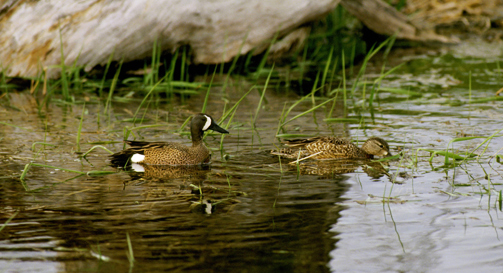BY Lee McClellan
FRANKFORT, Ky. – Kentucky waterfowl hunters now have additional days in September to pursue teal.
A teal-only season that is new for 2014 runs from Sept. 22 through Sept. 25. A combined wood duck and teal season opens Sept. 17 and closes Sept. 21.

Hunters may harvest up to six teal a day during the experimental teal-only season.
“Over the last several years, Kentucky, Tennessee and Florida have been working to obtain additional teal-only days at the end of their early wood duck seasons,” said Rocky Pritchert, migratory bird coordinator for the Kentucky Department of Fish and Wildlife Resources. “In late June, the U.S. Fish and Wildlife Service approved the request and allowed four additional days to be added to the end of the current wood duck and teal seasons.”
The permission from U.S. Fish and Wildlife Service came after the Kentucky Fish and Wildlife Commission set the dates for the 2014 September wood duck and teal seasons. This prevented the publication of the additional teal-only hunting days in the 2014-2015 Kentucky Hunting Guide for Dove, Wood Duck, Teal, Woodcock, Snipe and Crow.
Blue-winged teal are the second most abundant duck species in North America behind mallard ducks. They are approximately one-third of the size of a mallard. Hunters will likely encounter blue-winged teal in Kentucky, but they may also see green-winged teal. Cinnamon teal are native to the western United States and rare in Kentucky. Northern shovelers look similar to blue-winged teal, but have a much larger body and bill.
The largest concentrations of blue-winged teal migrate through the western part of the state. “Blue-winged teal prefer large shallow open waters and marshes, making them fairly accessible to Kentucky hunters,” Pritchert said. “Blue-wings are generally not as skittish as other duck species and don’t require much in the way of special equipment.”
Pritchert said a few decoys, waders and a little camouflage clothing will suffice for teal hunting. “Hunters can take advantage of natural cover around the water’s edge,” he said. “Hunters don’t need a blind if they stay low.”
Those without private land to hunt can find good teal hunting on the sloughs and lakes of Sloughs Wildlife Management Area (WMA) in Henderson and Union counties as well as on Ballard and Boatwright WMAs in Ballard County. The many ponds and lakes of Peabody WMA in Hopkins, Muhlenberg and Ohio counties also offer productive teal hunting.
“These wildlife management areas can offer some pretty exceptional teal hunting when birds are moving through,” Pritchert said.
Larger waters also offer good opportunities, such as the many shallow flats of Kentucky Lake and Lake Barkley. “Some central Kentucky reservoirs also attract teal,” Pritchert said. “When the birds are migrating, good concentrations have been seen on Green River, Cedar Creek Lake and Taylorsville Lake.”
Teal fly fast and close to the water; a test of any wing shooter’s skills. “They are challenging to hit because of their small size and erratic flying with lots of twists and turns,” Pritchert said.
Pritchert reminds hunters these additional hunting days are just for teal. “Make sure of your target before you shoot,” he said.
A valid Kentucky hunting license, a Kentucky migratory game bird – waterfowl permit along with a federal migratory bird hunting permit are required to hunt teal. Hunters may only use non-toxic shot while hunting any waterfowl species.
Author Lee McClellan is a nationally award-winning associate editor for Kentucky Afield magazine, the official publication of the Kentucky Department of Fish and Wildlife Resources. He is a life-long hunter and angler, with a passion for smallmouth bass fishing.
-30-
The Kentucky Department of Fish and Wildlife Resources manages, regulates, enforces and promotes responsible use of all fish and wildlife species, their habitats, public wildlife areas and waterways for the benefit of those resources and for public enjoyment. Kentucky Fish and Wildlife is an agency of the Tourism, Arts and Heritage Cabinet. For more information on the department, visit our website at fw.ky.gov.


Be the first to comment